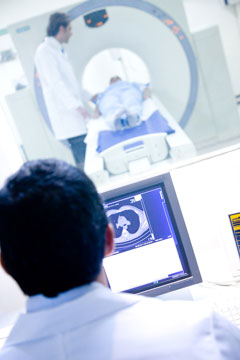
There are numerous terms which can be used to refer to spinal disc damage, and different doctors will often use different terminology, which can be confusing for patients. A bulging disc may also be known as a herniated disc, or even a pinched nerve. Unfortunately, there is often no exact definition for any particular term, and patients who seek different opinions may be frustrated by what they see as different diagnoses.
It’s more helpful for patients to know what the exact problem is that they have, and then have this problem confirmed by some form of medical imaging rather than just various doctors’ opinions. This is especially true if their spinal problem is so severe and painful that they are unable to perform work, and are trying to apply for Social Security Disability benefits.
When a patient suffers from a herniated disc (also known as a ruptured disc), the pain they experience is due to the herniation (or bulging part) of the disc impacting on the spinal cord, and thus “pinching” the nerve. The sort of pain this causes is described as radicular pain (a technical term for nerve root pain). Often, such pain radiates into other parts of the body, causing associated pain in the legs or arms (this generally depends on where the herniated disc is located on the spine, more specifically whether it’s in the upper or lower spine).
However, the problem for many people is made more complex when their doctor diagnoses simply a “pinched nerve”, as the same symptoms can occur due to other spinal conditions (such as spinal stenosis or bone spurs, neither of which is the same as a herniated disc). For this reason, it is essential for patients to have their spinal problem examined by a specialist in conjunction with some form of imaging test (such as a CT scan or an MRI scan), which can pinpoint the exact problem and confirm the diagnosis.
Even when an official diagnosis has been made, the pain itself is the biggest issue for people in terms of disability. Back pain for some people suffering from bulging or ruptured discs can be debilitating enough to render them virtually bed-ridden, or reliant on heavy doses of prescription pain medicine to allow them to perform basic functions. In some cases, it is impossible for a person suffering from such a condition to work at all, in which case they should be eligible for Social Security Disability benefits. However, winning a claim for Social Security Disability can be problematic for sufferers of extreme back pain, as the very notion of “pain” is a subjective one, and disability requires objective findings to support subjective complaints.
In order for those suffering from bulging discs or ruptured discs to qualify for a Social Security Disability payment, it is crucial that their diagnosis can be confirmed beyond a doubt, which means getting more than just a doctor’s diagnosis. Actual proof can often be seen in an MRI or CT scan, the specialist’s report where the doctor interprets the imaging exam and makes findings is also helpful. With enough objective evidence, and a carefully filed (complete) claim, those who suffer from extreme pain as a result of damaged discs and nerve pain have a much better chance of winning Social Security Disability benefits than those who present with only subjective evidence (of the pain itself).











{ 1 comment… read it below or add one }
Lower back pain is really so difficult to stop, sometimes, yoga exercise is a nice choice for pain relief.
{ 1 trackback }